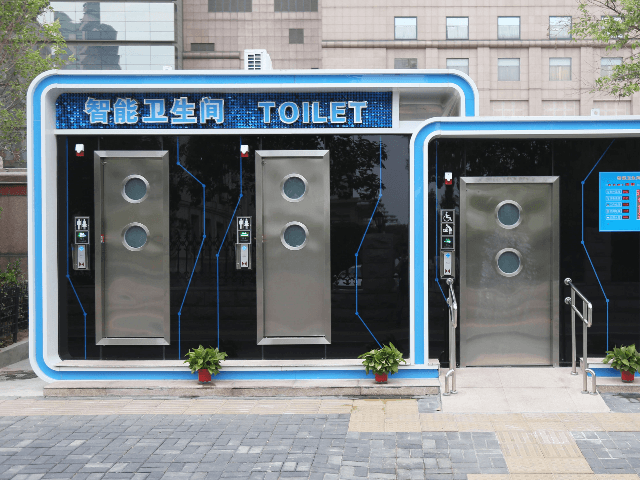A local official in Atush, Xinjiang, confirmed to Radio Free Asia (RFA) in an interview published Thursday that Chinese officials had built a public toilet at the site of a demolished Uyghur mosque.
The public bathrooms were reportedly not yet in use, nor was there any clear need for more public toilets in the area, the anonymous official reportedly said.
China launched a campaign in 2016 to demolish Uyghur mosques throughout Xinjiang, China’s largest and westernmost province. Officials also used other initiatives to erase Uyghur and other Turkic ethnic minority culture, including restrictions on wearing Islamic clothing in public, limits on the celebration of Muslim holidays such as Ramadan, and the widespread implementation of surveillance systems to monitor every move that local citizens make. China has also placed as many as 3 million Uyghurs and other Muslim minority members in concentration camps throughout Xinjiang, where they endure extreme human rights abuses, including forced sterilization, torture, rape, and death.
China describes the concentration camps as “vocational training” centers where underprivileged minorities learn skills that make them competitive in the Chinese economy. Survivors say they instead learn the Mandarin language – not native to Xinjiang – and are forced to memorize Communist Party propaganda and worship dictator Xi Jinping.
In addition to demolishing mosques, Chinese officials have leveled ancient Uyghur cemeteries, erasing physical records of family history. Outside of Xinjiang, Xi Jinping has launched a war on religion prompting the demolition of not just mosques, but of Christian churches, Buddhist temples, and ancient pagan holy sites.
The fate of the Tokul mosque in Atush, which RFA notes is a city of 270,000 people, has been demolition and replacement with public bathrooms, a move difficult not to interpret as a deliberate insult.
RFA identified the official who confirmed the news as a Uyghur local committee member, who attributed the choice of building a toilet there to “Han comrades” and noted that “they haven’t opened it yet.”
“People have toilets at home, so there weren’t any problems like that,” he reportedly said when asked if the area suffered from a lack of access to toilets. In some impoverished regions of the world, people without access to toilets have no way of hygienically doing away with their personal waste, resulting in the spread of disease. This could potentially be a concern in light of the acceleration of the spread of Chinese coronavirus in Xinjiang, but the local official did not seem to know of any such concern in the area.
“He conceded that the toilet was likely built to cover up the ruins of the destroyed Tokul mosque, as well as for the needs of inspecting groups or cadres visiting the area,” RFA noted. The site also recalled a similar instance of a mosque that Chinese officials leveled and replaced with a store selling haram items such as alcohol and cigarettes.
RFA estimated that the Communist Party had destroyed 70 percent of Xinjiang’s mosques at press time. Of those remaining, Communist Party officials reportedly forced believers to use many of them as Party ideology centers. RFA reporting from as early as 2017 revealed that locals were forced to use mosques for non-Islamic events such as “flag-raising ceremonies” to honor the Communist Party. Many are now draped in communist propaganda decor – banners with signs reading slogans such as “Love the Party, Love the Country.”
As China strictly controls who can enter the province, confirming the destruction of mosques relies significantly on the use of satellite imagery to monitor what buildings remain erect in what parts of the country. In 2019, for example, the website Bellingcat used satellite images to confirm the destruction of the 800-year-old Keriya Aitika Mosque in Hotan, one of the region’s largest cities. In addition to the leveling of that structure, satellite images revealed “significant structural changes” at other mosques that could be complete destruction, or at least enough modification to make the building unsuitable for a mosque.
According to the Islamic law (sharia), mosques must be built with certain features that make them proper sites for Friday prayers. Among those are the minaret, a tower from where clergy make the call to prayer; a mihrab, a niche in the wall that indicates the direction of Mecca; and the qubba, or domes.
The campaign to “Sinicize” all religions under dictator Xi Jinping has resulted in significant damage to mosque domes and other iconic architecture. The religious freedom site Bitter Winter reported last week that the campaign has transcended Xinjiang, affecting not only the mosques frequented by Uyghurs, but other ethnic minorities such as the Hui people.
Bitter Winter reported that 17 mosques in Gansu province lost Islamic iconography on their outside in March alone. At the time, China had imposed strict lockdown measures to combat the Chinese coronavirus, meaning citizens were not allowed out in public during much of the destruction occurring.
“Domes from at least eight mosques in Kongtong district’s Dazhai township and Gaoyuan village were also taken off amid the pandemic,” the site noted, referring to locations in Gansu and publishing photos of the mosques with awnings and empty space where many of their domes used to be.
Similar reports of destruction of Hui sites, including the removal of domes and minarets, surfaced in Ningxia, a northcentral region home to many of the nation’s Hui and bordering Gansu.

COMMENTS
Please let us know if you're having issues with commenting.